|
|
|
Sort Order |
|
|
|
Items / Page
|
|
|
|
|
|
|
| Srl | Item |
| 1 |
ID:
168983
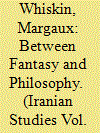

|
|
|
|
|
| Summary/Abstract |
Zadig ou la Destinée opens on a preface supposedly written by Sadi (sic), who seems to suggest he is the translator of the story which is to follow. The article will investigate the role played by Voltaire’s reference to Saʿdi in Zadig as an Oriental prop for the narrative’s exotic setting, but also, more importantly, as participating in its philosophical content. Travelers’ accounts had brought growing interest in Persia, and Saʿdi would not have been unfamiliar to an educated public; the Orient more generally became an experimental space for Enlightenment thought. Playing on the notion of the translator as cultural bridge, the article examines the uses Voltaire makes of Saʿdi in Zadig and whether these correlate to the eighteenth-century French reader’s perceptions of the Iranian poet.
|
|
|
|
|
|
|
|
|
|
|
|
|
|
|
|
| 2 |
ID:
168986


|
|
|
|
|
| Summary/Abstract |
This article follows a thread of translation and intertextual dialogue, taking us from the thirteenth-century Persian poet Saʿdi to the nineteenth-century French poet Marceline Desbordes-Valmore. It reads Desbordes-Valmore’s poem ‘Les roses de Saadi’ (1860) with the two passages from Saʿdi’s Golestān from which it was inspired, shedding new light on the poem’s metapoetic subtext. The original Persian text is compared to two French translations that were circulating at the time when Desbordes-Valmore was writing. This analysis of the Golestān’s reception forms the basis for the argument that Desbordes-Valmore recast in secular terms Saʿdi’s discourse on poetic language, emphasizing the continuity, rather than difference, between her concerns and Saʿdi’s. The case of Desbordes-Valmore thus reveals a forgotten facet of nineteenth-century French engagements with Middle Eastern culture: one of identification and literary influence, which existed alongside the processes of “othering” for which the period is better known.
|
|
|
|
|
|
|
|
|
|
|
|
|
|
|
|
| 3 |
ID:
168982


|
|
|
|
|
| Summary/Abstract |
This article presents two hitherto unstudied compilations of verses from the Bustān of Saʿdī. Both circulated in the Persianate world in the fifteenth and sixteenth centuries. The article provides an analysis of the compilations’ content as well as their relation to the complete Bustān. By highlighting certain stories and themes at the expense of others, and by ordering these passages in a way that differs from the complete Bustān, each compilation transforms Saʿdī’s text into a shorter, more homogenous composition, with distinct formal, thematic, and generic qualities. The shorter compilation presents a series of aphorisms, forming a mirror for princes. The longer one offers a selection of stories and lessons and emphasizes mystical themes, including aspects of Sufi erotic theology. This article also investigates the manuscript copies of these compilations, revealing their use and transmission in Iran, Turkey, and Central Asia between 1470 and 1550.
|
|
|
|
|
|
|
|
|
|
|
|
|
|
|
|
| 4 |
ID:
168985


|
|
|
|
|
| Summary/Abstract |
This article discusses two Polish translations of Saʿdi’s Golestān, prepared by Samuel Otwinowski and Wojciech Biberstein-Kazimirski (alias Albert Kazimirski de Biberstein) and published in 1879 and 1876 respectively. Though edited at the end of the nineteenth century, Otwinowski's translation had been originally completed in the first half of the seventeenth century and is assumed to be the first one or one of the very first renderings of Saʿdi's work into a European language. The question that remains unresolved is whether or not Otwinowski's translation, despite being unpublished, was known to seventeenth- and eighteenth-century Polish poets. One can find some stories and motifs “picked” from Saʿdi’s Golestān in their poetry, but they seem more likely to have been influenced by non-Polish renderings. This article describes the different translation strategies adopted by the two translators, the literarily gifted dragoman Otwinowski and the nineteenth-century philologist Biberstein Kazimirski.
|
|
|
|
|
|
|
|
|
|
|
|
|
|
|
|
| 5 |
ID:
168994


|
|
|
|
|
| Summary/Abstract |
This article presents a very rare manuscript of a Muntakhab al-Suwar (selection of Qur’anic chapters) calligraphed by Ibrāhīm Sulṭān b. Shāhrukh. This manuscript was transcribed in large format in Ramaḍān 830 AH/June 1427 AD and endowed to the holy shrine of Shāh-Chirāgh in Ramaḍān 834 AH/May‒June 1431 AD. Therefore, it is considered to be one of the last known works calligraphed by Ibrāhīm Sulṭān. It is kept in the Pars museum in Shiraz. In this article, the unique codicology and special characteristics of this masterpiece are studied, and the important historical aspects of Ibrāhīm Sulṭān and the art works attributed to him are elaborated. The style of his calligraphy will also be examined to find out the sources of inspiration for his distinct style.
|
|
|
|
|
|
|
|
|
|
|
|
|
|
|
|
| 6 |
ID:
168992
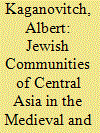

|
|
|
|
|
| Summary/Abstract |
When the Jews first settled in Central Asia is uncertain, but circumstantial evidence clearly indicates that this happened at least two and a half thousand years ago. In the first millennium AD, the Jews lived only in cities no farther than 750 km east of the Caspian sea (in the eighth–eleventh centuries the sea was called Khazarian). Only later did they migrate to the central part of the region, to cities like Samarkand and Bukhara. It is possible that Jews from Khazaria joined them, since they already had tight trade connections with Central Asia and China. There is no trace of evidence regarding the existence of Jews in the entirety of Central Asia in the early sixteenth century. At the very end of the sixteenth century Bukhara became the new ethnoreligious center of the Jews in that region. In the first half of the nineteenth century, thanks to European travelers visiting Central Asia at that time, the term “Bukharan Jews” was assigned to this sub-ethnic Jewish group. Drawing on a wide range of primary and secondary source materials, this article aims to prove that the presence of Jews in Central Asia was not continuous, and therefore the modern Bukharan Jews are not descendants of the first Jewish settlers there. It also attempts to determine where Central Asia’s first Jewish population disappeared to.
|
|
|
|
|
|
|
|
|
|
|
|
|
|
|
|
| 7 |
ID:
168990


|
|
|
|
|
| Summary/Abstract |
This study examines the character of Kush-e Pildandān, the anti-hero of the Kushnāmeh, by arguing that the protagonist of the poem represents the monarchs of the Kushan dynasty. In order to substantiate this claim, the Kushnāmeh is introduced and the process of its formation and its reflections of Kushan history are examined. Then the various components of this image of the enemy are discussed. What is revealed is a polemical strategy of creating an enemy, a unique insight into the political ideology of the Sasanian period. The study offers a glimpse into the ideological discourse of political power in the Late Antique period, and how they drew upon a shared conceptualization of the past.
|
|
|
|
|
|
|
|
|
|
|
|
|
|
|
|
| 8 |
ID:
168991


|
|
|
|
|
| Summary/Abstract |
The article focuses on a very particular episode of the eastern Alexander legend, i.e. the building of an extraordinary “metal army” employed by Alexander in his war against the Indian King Porus, which is present in at least three Persian accounts written between the tenth and fourteenth centuries CE: the “Book of Kings” (Shāh-nāmeh) by Ferdowsi, the “Book of Dārāb” (Dārāb-nāmeh), attributed to Tarsusi, and an “Alexander-book” (Eskandar-nāmeh) in prose copied by ʿAbd al-Kāfi ibn Abu al-Barakāt. Compared to the most remote source, the text of Pseudo-Callisthenes, and to the closest ones (the Armenian version of the fifth century, the Syriac text of the sixth‒seventh centuries, and the Hebrew version of the tenth‒eleventh centuries), it is argued that the Persian authors have not passively received the inherited materials; on the contrary, they have been able to liven up the scene of Alexander’s battle against the Indian King Porus by bringing onto the battlefield a fiery and phantasmagorical army of metal, giving us one of the more amazing episodes in the eastern legend of the great Macedonian.
|
|
|
|
|
|
|
|
|
|
|
|
|
|
|
|
| 9 |
ID:
168984


|
|
|
|
|
| Summary/Abstract |
From the seventeenth century, Mosleh al-Din Saʿdi Shirazi (d. 1291), a key figure in Persian classical literature, became the center of Europeans’ attention: his name appeared in travelogues and periodicals, and selections of his tales were published in miscellaneous Latin, German, French, and English works. To follow Saʿdi’s impact on English literature, one needs to search for the beginning of the “Saʿdi trend” and the reasons that led to the acceleration of the translation process of his works into the English language in the nineteenth century. This article examines the role of the British educational institutions in colonial India in the introduction of Saʿdi and his Golestān to the English readership, and, in parallel, it uncovers the role of the Indo-Persian native scholars (monshis) who were involved in the preparation of translations. The article discusses how the perception of the British towards Saʿdi’s literature developed in the first half of the nineteenth century and how their approach towards the translation of the “text” and its “style” evolved in the complete renderings of the Golestān.
|
|
|
|
|
|
|
|
|
|
|
|
|
|
|
|
| 10 |
ID:
168993
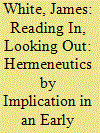

|
|
|
|
|
| Summary/Abstract |
This article investigates aspects of mise-en-page in British Library Add. MS. 27261, an anthology of twenty-three texts on mixed subjects produced for Eskandar Soltān (d. 818/1415), grandson of Timur and self-styled ruler of territories in southern Iran during the early fifteenth century. It examines the juxtaposition of literary and scientific texts together with images in Add. MS. 27261, and explores the correlations that these juxtapositions create. It concludes that the London anthology should be seen as a coherent intellectual enterprise, and as an interpretative project designed to feed Eskandar’s experiments with different forms of knowledge.
|
|
|
|
|
|
|
|
|
|
|
|
|
|
|
|
| 11 |
ID:
168988


|
|
|
| 12 |
ID:
168981


|
|
|
|
|
| Summary/Abstract |
This article presents a study of two coeval works on morals: the first belongs to the classic Persian tradition, the Golestān (The Rose Garden) by Saʿdi (Shirāz 1210–91 or 1292); the second, Il libro de’ vizî e delle virtudi (Book of Vices and Virtues) by Bono Giamboni (Florence 1240–92), belongs to the first didactic prose in vernacular Italian. The study will specially concern the theme of temperance قناعت qanāʿat, central to both Islamic and Christian morals. An analysis is made of passages dedicated to this theme in both texts, also through comparative observations, in order to identify the approach characteristic to each work.
|
|
|
|
|
|
|
|
|
|
|
|
|
|
|
|
| 13 |
ID:
168995


|
|
|
|
|
| Summary/Abstract |
This article looks at the efforts China and Iran made towards strengthening themselves and their search for independence and integrity after the First World War. Since the nineteenth century, the two countries had been in a similar situation, under pressure from treaties and rivalries with European powers. The change of the world order brought about by the 1914–18 war created an opportunity for China and Iran to claim back their rights, such as ending extra-territoriality. After the war, the Fourteen Points drawn up by the American president, Woodrow Wilson, gave hope for China and Iran to maintain their independence and integrity. During the Paris Peace Conference of 1919, China and Iran made both gains and losses. China was unable to solve the Shandong Problem but became one of the founding members of the League of Nations, while Iran did not get access to the Peace Conference but obtained Britain’s assurance of independence and integrity by signing the Anglo-Iranian Treaty of 1919, and then joined the League of Nations. China and Iran attempted to bring about cooperation between Asian countries, and therefore signed a treaty in 1920. The significance of the treaty was that the two countries agreed not to grant extra-territoriality to each other, which was what both countries were seeking to achieve at that time.
|
|
|
|
|
|
|
|
|
|
|
|
|
|
|
|
| 14 |
ID:
168987
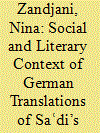

|
|
|
|
|
| Summary/Abstract |
Saʿdi’s Golestān has been translated into German numerous times since the seventeenth century. The purpose of this article is to examine the social and literary context of three German translations and translators: Karl Heinrich Graf, a theologian and researcher of the Old Testament, published his translation of the Golestān in 1846 during German Romanticism; Dieter Bellmann, a professor of Oriental studies, published a revision of Graf’s Rosengarten in 1982 in the German Democratic Republic, where literature was strictly regulated; Kathleen Göpel published her indirect translation from English, prepared by the Afghan translator Omar Ali-Shah, in 1997, at a time of intercultural literature, also called “bridge literature.” Through examples the article shows how the context may have influenced their translations and how the text has changed when traveling across linguistic and cultural borders.
|
|
|
|
|
|
|
|
|
|
|
|
|
|
|
|
| 15 |
ID:
168989
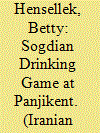

|
|
|
|
|
| Summary/Abstract |
This article reconsiders the religio-ritualistic interpretations of the use of the rhyton within eighth-century CE Sogdiana. Through a close art-historical analysis, it argues that three eighth-century wall paintings from Panjikent illustrate a drinking game. This proposal expands the current breadth of meaning attributed to the imagery decorating Sogdian homes. Not only could the paintings illustrate epic narratives, religious veneration, or moral didacticism, but they could also celebrate conviviality, fun, and humor.
|
|
|
|
|
|
|
|
|
|
|
|
|
|
|
|
|
|
|
|
|